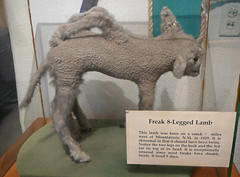
New Mexico's first governor, Charles Bent, above, who met a horrific death at his Taos home that is now a museum with freaky artifacts.
The U.S. government was not welcomed with open arms to New Mexico after it fell to American troops at the Battle of Santa Fe in August 1846.
Five months later, a group of Indians and their former Mexican occupiers revolted and brutally murdered Charles Bent, a successful merchant to the Southwest who had been appointed the territory’s first governor.
On a visit with his family in Taos in January 1847, the angry mob stormed his house, shot him with bullets and arrows and scalped him in front of his wife and children. To the natives, Bent represented everything bad the Anglo-Americans had done to them as the West was won.
“We want your head gringo,” Bent’s daughter, Teresina Bent Scheurich, wrote years later in a two-page, poorly spelled history of the murder. “Yes … you have to died now so that no American is going to govern us …,” she wrote, quoting the remarks of the attackers.
The surviving Bents, that frightful night, shoveled a hole through their adobe walls to escape to a neighboring house.
American troops were immediately summoned to Taos to quell the rebellion. They killed 250 people in Taos Pueblo, and hanged six Mexicans in the Indian village’s plaza. A short time later, 16 Indians were strung up in downtown Taos for the Bent murder, the governor’s daughter wrote.
Copies of her story can be purchased for 50 cents apiece in a dusty museum and gift store at the Bent House in the perfectly restored tourist destination 61 miles north of Santa Fe. Few people seem to wander into the adobe building tucked away from the trendy shops, restaurants and art galleries.
The museum contains a hodgepodge collection of old tools, photographs and antique furniture, much of which appears to have nothing to do with the Bent family.

The strangest thing on exhibit is a stuffed, “freak” lamb that supposedly was born on a nearby ranch in 1929 with two hind ends and eight legs, two of which extend from the creature’s back. It lived for five days before being sent to a taxidermist and later acquired by this museum, which leaves its lights off until someone steps inside.

No comments:
Post a Comment